When your doctor diagnoses a tumor, is it time to worry? Not at all. A tumour is not the same thing as cancer. However, some tumours are cancerous and may be life-threatening conditions.
There are several types of tumors. Some of them will never develop into dangerous lesions and do not need medical expert attention. But sometimes, they are malignant and damage other tissues and organs. How can you distinguish between them? Read on, to learn when to stay alert.
What is a tumor?
The tumour (also called neoplasm) is a mass of abnormal cells forming inside the body. It can affect any tissue or organ. The tumor may be malignant, but it is not always the case. Precancerous cells may form tumours, too.
The tumour consists of
- normal cells
- abnormal or cancerous cells (including tumour stem cells)
- immune cells
- cancer-associated fibroblasts
- blood vessel.


The tumour can be easily distinguished from a cyst, another type of lesion. While the tumour is a solid mass of cells, the cyst is a sac containing fluid or air. Similarly to tumours, they can be benign or cancerous, but most cysts are benign.
What are the types of tumours?
Tumour character depends on certain traits. We can distinguish three types of tumours:
- Noncancerous. These tumours are also called benign. They do not spread to other body parts. They do not threaten your life, and the majority of them do not require treatment. Doctors remove them when they cause pain or press on vessels.
- Precancerous. These tumours are benign but may turn into cancer if left untreated.
- Cancerous. Cancerous tumours invade nearby tissues and spread to other body parts, forming metastases. Cancerous tumours can return after treatment and be life-threatening.
Examples of cancerous (malignant) tumours include:
- Brain tumours, such as glioblastoma and astrocytoma
- Bone tumours, such as osteosarcoma and chordomas
- Soft tissue tumours and sarcomas
- Cancers developing in specific organs (lung cancer and pancreatic cancer)
- Ovarian or testicle germ cell tumours
- Skin tumours such as squamous cell carcinoma.
Examples of noncancerous (benign) tumours include:
- Osteomas – benign bone tumours,
- Brain tumours (E.g., meningiomas and schwannomas),
- Gland tumours such as pituitary adenomas,
- Lymphatic tumours (E.g., angiomas),
- Soft tissue tumours such as lipomas,
- Fibroids or fibromas (E.g., Uterine fibroids).
Examples of precancerous tumours (benign but with an option to become malignant) include:
- Actinic keratosis (located on the skin),
- Cervical dysplasia,
- Colon polyps,
- Ductal carcinoma in situ (a type of breast
tumour).
What is the difference between cancer and a tumor?
Not all tumours will progress to cancer. Some abnormal cells form lumps in the body but do not spread. When abnormal cells grow uncontrollably and spread, they are cancerous.
| Tumour (neoplasm) | ||
| Trait | Benign | Malignant (Cancer) |
| 1. Differentiation (developing into a particular cell type) | ● Well differentiated ● Look like the tissue from which they originated | ● Poorly differentiated ● It does not look like an original tissue ● Anaplasia |
| 2. Growth rate | ● Usually grows slowly | ● Usually grows quickly |
| 3. Local invasion | ● Does not invade nearby tissues | ● Spreads around |
| 4. Metastasis | ● Does not affect other body parts | ● Spreads to other organs |
Tab. Four differences between benign and malignant tumours.
Different factors cause benign tumours and cancers. The main factors promoting benign lumps are:
- chronic inflammation,
- infection,
- prolonged stress, or,
- injury in a particular location.
The causes of cancer development seem more complex. Medical experts defined some of them, but the others are still unclear. Commonly recognised risk factors include:
- mutations,
- smoking and drinking alcohol,
- unhealthy diet,
- lack of physical activity,
- pollution,
- exposure to toxins, chemicals, and heavy metals.
Tumours and cancer also differ in symptoms. For example, benign tumours mostly do not show any signs. But this, of course, depends on its location. A benign tumour may lead to aches, visual disturbances, or memory problems (if located in the brain), because it can affect surrounding structures and press on them.
Some symptoms of benign tumours include:
- pain and discomfort,
- fatigue,
- weight loss,
- fever,
- chills and rigors,
- lack of appetite,
- night sweats.
Symptoms listed above can also accompany cancer. Still, cancer symptoms usually are more severe and affect the whole organs.
Examples of cancer symptoms include:
- chest pain, shortness of breath, and persistent cough,
- unexplained weight loss,
- change in bowel habits,
- change in the size and colour of the tumour (on the skin),
- blood in urine or stool.
Benign tumours do not need treatment unless they cause some unpleasant symptoms. Usually, doctors recommend observing them, but they may remove some.
Treating cancer includes surgery, chemotherapy, radiotherapy, and immunotherapy. These treatments are very powerful because they need to destroy cancer cells and often cause severe side effects.
How is a tumor formed?
The tumour development follows four phases. Each can take several years.
- Mutations. A normal cell mutates, starts dividing, and grows uncontrollably. Typically, several mutations are needed for cancer transformation. DNA changes caused by harmful factors, like chemicals, pollutants, and free radicals, accumulate at this stage. In most cases, immune cells destroy those damaged cells and prevent cancer development.
- Carcinoma in situ. When a group of cancer cells forms a tumour localised in one place, doctors call it carcinoma in situ. Usually, this phase lasts five to ten years. If the tumour has enough oxygen and nutrients supplied by new blood vessels, it can proceed to the third phase.
- Invasion. This stage may last a few months or, in some cases, even five years. Cancer releases signals for blood vessels to grow. The blood supplies cancer with enough oxygen, glucose, and hormones to maintain a rapid rate of growth.
- Metastasis. It is the final phase when cancer cells disseminate to other organs. The metastasis length is similar to that of the invasive phase. The cancer cells recruit immune cells to help them spread with blood and lymph to other body parts.
How fast can a tumor grow?
It depends on the type of tumour. But generally, the initial phase of tumour development is quite long. That is why doctors diagnose most tumours in older people, because they have enough time to form.
At that stage, cancer cells may appear in majority of cases. Still, they will never develop to the cancer stage, as long as our natural repair and defence systems work efficiently.
However, if cancer forms a small tumour and manages to stimulate blood vessels to form around it, the growth may accelerate, especially, at the invasion and metastasis stages.
Are tumors hard or soft?
Depending on the tumour type, and the tissue they originate from, they can be hard or soft.
Hard tumours include lesions of:
- bones,
- cartilage,
- breast,
- prostate,
- lung,
- colon, and
- rectum.
Soft tumours include lesions of:
- brain,
- lymph nodes,
- mouth,
- throat,
- liver,
- pancreas,
- skin, as well as
- leukaemia/lymphoma.
Does a tumor hurt?
It depends on the tumour type and location. Usually, each type of tumour manifests with its unique repertoire of signs. Sometimes tumours can be painless, other may cause only mild discomfort, and in some cases, they may cause pain.
Cancers feel more rubbery than healthy tissue as they contain more blood vessels. Doctors cannot determine the nature of the tumour by simply palpating it.
The tumour may lead to other health problems, such as vision loss or paralysis.
To wrap up
A tumor is composed of excessively growing cells. Benign tumours stay localised, while malignant ones spread and destroy other tissues. At the early stages of its development, cancer does not show any signs. This stage may last decades. Only screening tests can detect small tumours.
The stage when cancer invades nearby tissues and disseminates in the body, may last from few months to few years. Usually, it is harder to treat tumours big enough to be seen or manifest symptoms. However, the earlier doctors diagnose you, the higher your chances for successful treatment.
